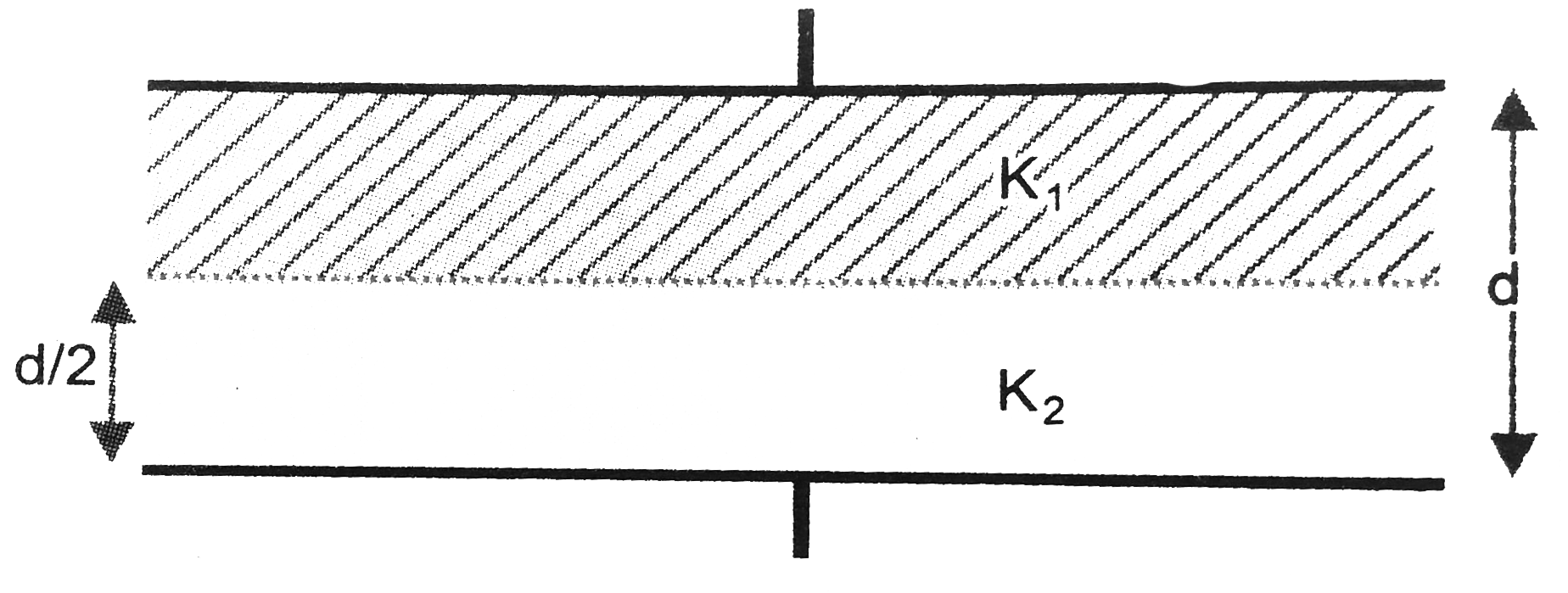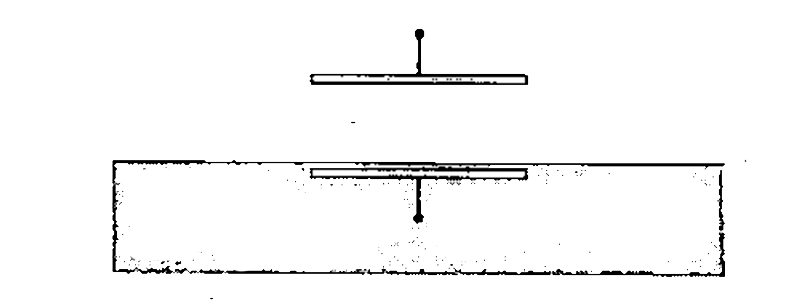A parallel plate capacitor is located horizontally, so that one of its plates is submerged into liquid while the other is over the surface. The dielectric constant of the liquid is equal to k. Its density is equal to ρ. To what height will the level of the liquid in the capacitor rise after its plates gets a charge of surface density σ ?
 .
.
One way of doing this problem will be exactly as in previous case so let us try an alternative method based on energy. Suppose the liquid rises by a distance h. Then let us calculate the extra energy of the liquid as a sum of polarization energy and the ordinary gravitional energy. Teh latter is
12h.ρg.Sh=12ρgSh2
If σ is the free charge surface density on the plane, the bound charge density is, from the previous problem,
σ'=ε−1εσ
This is also the vol,ume density of induced dipole moment i.e, Polarization Then the energy is, as before
−12.σ'E0=−12σ'σε0=−(ε−1)σ22ε0ε
and the total polarization energy is
−S(a+h)(ε−1)σ22ε0ε
Then, total energy is
U(h)=−S(a+h)(ε−1)σ22ε0ε+12ρgSh2
The actual height to which the liquid risea is detemined from the formula
dUdh=U'(h)=0
This gives h=(ε−1)σ22ε0ερg.

Topper's Solved these Questions
- ELECTRODYNAMICSBook:IE IRODOV, LA SENA & SS KROTOVChapter:ELECTRODYNAMICSExercise:Electric Current
Explore 72 Videos
- ELECTRODYNAMICSBook:IE IRODOV, LA SENA & SS KROTOVChapter:ELECTRODYNAMICSExercise:Constant Magnetic Fiels - Magnetics
Explore 69 Videos
- ELECTRODYNAMICSBook:IE IRODOV, LA SENA & SS KROTOVChapter:ELECTRODYNAMICSExercise:Conductors And Dielectrics In An Electric Field
Explore 47 Videos
- ELECTRICITY AND MAGNETISMBook:IE IRODOV, LA SENA & SS KROTOVChapter:ELECTRICITY AND MAGNETISMExercise:All Questions
Explore 6 Videos
- ELECTROMAGNETISMBook:IE IRODOV, LA SENA & SS KROTOVChapter:ELECTROMAGNETISMExercise:All Questions
Explore 24 Videos
Similar Questions
A parallel plate capacitor is filled with dielectrics as shown in Fig. What is its capacitance ?

View SolutionA parallel-plate capacitor with vertical plates is connected to a voltage source and then submerged into a liquid dielectric. How does the level of the dielectric between the plates change in the process? Explain the change of the energy stored by the capacitor
View Solution
Knowledge Check
A parallel plate capacitor is located horizontally such that one of the plates is submerged in a liquid while the other is above the liquid surface. When plates are charged, the level of liquid.
 ArisesBfallsCremains unchangedDmay rise of fail depending on the amount of charge
ArisesBfallsCremains unchangedDmay rise of fail depending on the amount of chargeWhen a parallel plate capacitor is filled with wax after separation between plates is doubled, its capacitance becomes twice. What is the dielectric constant of wax?
A1B2C3D4In a parallel plate capacitor with plate area A and charge Q, the force on one plate because of the charge on the other is equal to
AQ2ε0A2BQ22ε0A2CQ2ε0ADQ22ε0A
Figure shows a horizontal parallel plate capacitor is lowered on a liquid surface in such a way that its lower plate is just submerged in the liquid of dielectric constant k. Find the height to which the liquid level will be raised between the plates if the capacitor plates are given a surface charge density +σ and−σ on its plates.

View SolutionA parallel plate capacitor is charged by a battery . After sometime the battery is disconnected and a dielectric slab with its thickness equal to the plate separation is inserted between the plates . How will the capacitancee of the capacitor. ? Justify your answer
View SolutionA parallel plate capacitor is charged by a battery . After sometime the battery is disconnected and a dielectric slab with its thickness equal to the plate separation is inserted between the plates . How will the energy stored in the capacitor be affected ? Justify your answer
View SolutionThe plates of a parallel plate capacitor are, not exactly parallel. The surface charge density therefore :
View SolutionThe plates of a parallel plate capacitor are, not exactly parallel. The surface charge density therefore :
View Solution

